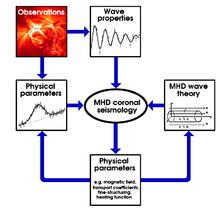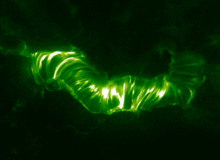- Coronal seismology
-
Coronal seismology is a technique of studying the plasma of the Sun's corona with the use of magnetohydrodynamic (MHD) waves and oscillations. Magnetohydrodynamics studies the dynamics of electrically conducting fluids - in this case the fluid is the coronal plasma. Observed properties of the waves (e.g. period, wavelength, amplitude, temporal and spatial signatures[clarification needed], characteristic scenarios of the wave evolution[clarification needed]), combined with a theoretical modelling of the wave phenomena (dispersion relations, evolutionary equations, etc.), reveal physical parameters of the corona which are not open to direct observations, such as the coronal magnetic field strength and Alfvén velocity [1] and coronal dissipative coefficients.[2] Originally, the method of MHD coronal seismology was suggested by Y. Uchida in 1970[3] for global seismology (standing waves) and B. Roberts et al. in 1984 [4] for local seismology (propagating waves), but was not practically applied until the late 90s due to a lack of necessary observational resolution. Philosophically, coronal seismology is similar to the Earth's seismology, helioseismology, and MHD spectroscopy of laboratory plasma devices. In all these approaches, waves of various kind are used to probe a medium.
The theoretical foundation of coronal seismology is the dispersion relation of MHD modes of a plasma cylinder: a plasma structure which is nonuniform in the transverse direction and extended along the magnetic field. This model works well for the description of a number of plasma structures observed in the solar corona: e.g. coronal loops, prominence fibrils, plumes, various filaments. Such a structure acts as a waveguide of MHD waves.
This discussion is adapted from Valery M. Nakariakov and Erwin Verwichte, "Coronal Waves and Oscillations", Living Rev. Solar Phys. 2, (2005), (cited on November 26, 2009).
Contents
Types of magnetohydrodynamic waves
There are several distinct kinds of MHD modes which have quite different dispersive, polarisation, and propagation properties:
- Kink (or transverse) modes, which are oblique fast magnetoacoustic (also known as magnetosonic waves) guided by the plasma structure; the mode causes the displacement of the axis of the plasma structure. These modes are weakly compressible, but could nevertheless be observed with imaging instruments as periodic standing or propagating displacements of coronal structures, e.g. coronal loops. The frequency of transverse or "kink" modes is given by the following expression:
For kink modes the parameter m is equal to 1.
- Sausage modes, which are also oblique fast magnetoacoustic waves guided by the plasma structure; the mode causes expansions and contractions of the plasma structure, but does not displace its axis. These modes are compressible and cause significant variation of the absolute value of the magnetic field in the oscillating structure. The frequency of sausage modes is given by the following expression:
For sausage modes the parameter m is equal to 0.
- Longitudinal (or slow, or acoustic) modes, which are slow magnetoacoustic waves propagating mainly along the magnetic field in the plasma structure; these mode are essentially compressible. The magnetic field perturbation in these modes is negligible. The frequency of slow modes is given by the following expression:
Where we define Cs as the sound speed and CA as the Alfvèn speed.
- Torsional (Alfvén or twist) modes are incompressible transverse perturbations of the magnetic field along certain individual magnetic surfaces. In contrast with kink modes, torsional modes cannot be observed with imaging instruments, as they do not cause the displacement of either the structure axis or its boundary.
Observations
Wave and oscillatory phenomena are observed in the hot plasma of the corona mainly in EUV, optical and microwave bands with a number of spaceborne and ground-based instruments, e.g. the Solar and Heliospheric Observatory (SOHO), the Transition Region and Coronal Explorer (TRACE), the Nobeyama Radioheliograph (NoRH, see the Nobeyama radio observatory). Phenomenologically, researchers distinguish between compressible waves in polar plumes and in legs of large coronal loops, flare-generated transverse oscillations of loops, acoustic oscillations of loops, propagating kink waves in loops and in structures above arcades (an arcade being a close collection of loops in a cylindrical structure, see image to right), sausage oscillations of flaring loops, and oscillations of prominences and fibrils (see solar prominence), and this list is continuously updated.
Coronal seismology is one of the aims of the Atmospheric Imaging Assembly (AIA) instrument on the Solar Dynamics Observatory (SDO) mission.
A mission to send a spacecraft as close as 9 solar radii from the sun, NASA Solar probe, is planned for launch in 2015 and aims to provide in-situ measurements of the solar magnetic field, solar wind and corona. It should include a magnetometer and plasma wave sensor, allowing unprecedented observations for coronal seismology.
Conclusions
The potential of coronal seismology in the estimation of the coronal magnetic field, density scale height, "fine structure" (by which is meant the variation in structure of an inhomogeneous structure such as an inhomogeneous coronal loop) and heating has been demonstrated by different research groups. Work relating to the coronal magnetic field was mentioned earlier.[1] It has been shown that sufficiently broadband slow magnetoacoustic waves, consistent with currently available observations in the low frequency part of the spectrum, could provide the rate of heat deposition sufficient to heat a coronal loop.[5] Regarding the density scale height, transverse oscillations of coronal loops that have both variable circular cross-sectional area and plasma density in the longitudinal direction have been studied theoretically. A second order ordinary differential equation has been derived describing the displacement of the loop axis. Together with boundary conditions, solving this equation determines the eigenfrequencies and eigenmodes. The coronal density scale height could then be estimated by using the observed ratio of the fundamental frequency and first overtone of loop kink oscillations.[6] Little is known of coronal fine structure. Doppler shift oscillations in hot active region loops obtained with the Solar Ultraviolet Measurements of Emitted Radiation instrument (SUMER) aboard SOHO have been studied. The spectra were recorded along a 300 arcsec slit placed at a fixed position in the corona above the active regions. Some oscillations showed phase propagation along the slit in one or both directions with apparent speeds in the range of 8–102 km per second, together with distinctly different intensity and line width distributions along the slit. These features can be explained by the excitation of the oscillation at a footpoint of an inhomogeneous coronal loop, e.g. a loop with fine structure.[7]
References
- ^ a b Nakariakov, V.M.; Ofman, L. (June 2001). "Determination of the coronal magnetic field by coronal loop oscillations". Astronomy and Astrophysics 372 (3): L53–L56. Bibcode 2001A&A...372L..53N. doi:10.1051/0004-6361:20010607.
- ^ Nakariakov, V.M.; Ofman, L.; Deluca, E.E.; Roberts, B.; Davila, J.M. (August 1999). "TRACE observation of damped coronal loop oscillations: Implications for coronal heating". Science 285 (5429): 862–864. Bibcode 1999Sci...285..862N. doi:10.1126/science.285.5429.862. PMID 10436148.
- ^ Uchida, Y. (1970). "Diagnosis of coronal magnetic structure by flare-associated hydromagnetic disturbances". PASJ 22: 341–364. Bibcode 1970PASJ...22..341U.
- ^ Roberts, B., Edwin, P. M.; Benz, A. O. (1984). "On coronal oscillations". ApJ 279: 857–865. Bibcode 1984ApJ...279..857R. doi:10.1086/161956.
- ^ Tsiklauri, D.; Nakariakov, V.M. (December 2001). "Wide-spectrum slow magnetoacoustic waves in coronal loops". Astronomy and Astrophysics 379 (3): 1106–1112. arXiv:astro-ph/0107579. Bibcode 2001A&A...379.1106T. doi:10.1051/0004-6361:20011378.
- ^ Ruderman, M.S.; Verth, G.; Erdelyi, R. (October 2008). "Transverse Oscillations of Longitudinally Stratified Coronal Loops with Variable Cross Section". The Astrophysical Journal 686 (1): 694–700. Bibcode 2008ApJ...686..694R. doi:10.1086/591444.
- ^ Wang, T.J. et al (August 2003). "Hot coronal loop oscillations observed with SUMER: Examples and statistics". Astronomy and Astrophysics 406 (3): 1105–1121. Bibcode 2003A&A...406.1105W. doi:10.1051/0004-6361:20030858.
External links
- Nakariakov, V.M., Verwichte, E. (2005). "Coronal waves and oscillations". Living Rev. Solar Phys. 2: 3. http://www.livingreviews.org/lrsp-2005-3.
- Roberts, B., Nakariakov, V.M., "Coronal seismology – a new science", Frontiers 15, 2003
- Verwichte, E., Plasma diagnostics using MHD waves
Categories:- Sun
- Solar phenomena
- Space plasmas
- Plasma physics
- Waves in plasmas
Wikimedia Foundation. 2010.






